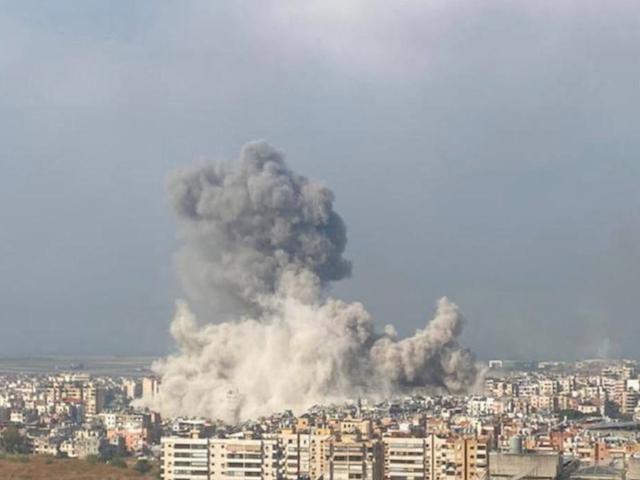In a dramatic escalation of the ongoing conflict in Lebanon, Israeli airstrikes have targeted key Hamas and Hezbollah positions across the country, marking a significant intensification in the regional war. On Saturday, a powerful strike in northern Lebanon claimed the life of senior Hamas official Saeed Atallah Ali and his entire family, sending shockwaves through the militant group. The attack occurred in a refugee camp, demonstrating Israel's strategic reach deep into Lebanese territory. Hamas later confirmed that another of its military operatives was eliminated in a separate strike in the Bekaa Valley, further eroding the group's command structure.
These strikes are part of a broader Israeli military operation that began earlier this week, coinciding with a ground incursion into southern Lebanon. The operation targets Hezbollah’s military infrastructure and has already claimed the lives of nine Israeli soldiers. Israeli forces are systematically dismantling Hezbollah's capabilities in the region, unearthing and destroying a sprawling 250-meter tunnel complex near the Israeli-Lebanese border. This tunnel, equipped with living quarters, showers, and a kitchen, was stocked with weapons, food, and combat gear, showing the extensive preparations Hezbollah had made for a prolonged conflict. However, Israeli forces ensured that the tunnel would no longer serve as a strategic asset for Hezbollah by destroying it and neutralizing its command centers.
🚨 Breaking: Saeed Atullah Ali, a senior H×mas commander, was eliminated in Tripoli in northern Lebanon.
— Dr. Eli David (@DrEliDavid) October 5, 2024
Note how Israel eliminated him with a targeted strike to his apartment, without harming his neighbors. pic.twitter.com/Z5hM4WX7fG
Saturday's strikes in Lebanon did not stop at the north. In a show of force, Israel's military also targeted Hezbollah strongholds in the southern suburbs of Beirut, particularly in the Haret Hreik and Choueifat neighborhoods. These areas, known for their dense population and significant Hezbollah presence, were rocked by explosions that illuminated the Beirut skyline. The strikes followed a day of intermittent bombardments and constant surveillance by Israeli drones, which buzzed ominously over the city. The Israeli Defense Forces (IDF) urged civilians to evacuate these neighborhoods, adding urgency to an already fraught situation.
Lebanon is increasingly caught in the crossfire of the broader Israel-Hamas conflict, which erupted after Hamas's brutal and unprecedented cross-border attack on October 7, 2023. The assault left 1,200 Israelis dead and 250 taken hostage, prompting Israel to declare all-out war on the Gaza-based militant group. Since then, the conflict has spiraled, with Hezbollah entering the fray by launching attacks from Lebanese territory. Both sides have been trading fire almost daily across the Lebanon-Israel border, with Hezbollah launching missiles into Israel and Israel responding with overwhelming force.
🚨BREAKING🚨 The IDF has carried out a targeted assassination in the Dahiya, Beirut. pic.twitter.com/Jrl4IHUAp2
— Raylan Givens (@JewishWarrior13) October 6, 2024
The toll on Lebanon has been devastating. According to the Lebanese Health Ministry, nearly 2,000 people have been killed since the conflict reignited, many of them civilians caught in the crossfire. Thousands of Palestinian refugees and Lebanese citizens have fled their homes, seeking safety from the expanding conflict. Israel's airstrikes, targeting both Hamas and Hezbollah, have left a trail of destruction across the country, disrupting infrastructure and isolating parts of Lebanon. On Friday, an Israeli airstrike severed a major highway connecting Lebanon and Syria, leaving enormous craters on either side of the road and cutting off vital supply lines for both military and civilian purposes.
Globally, the conflict has triggered mass protests and rallies as the war reaches a grim one-year anniversary. The toll in Gaza is staggering, with over 41,000 Palestinians reported dead, more than half of them women and children, according to Hamas health officials. This humanitarian catastrophe has only deepened international outrage, with calls for ceasefires growing louder, even as Israel continues its military operations unabated.
This is a 250 meter Hezbollah tunnel, built to carry out the next October 7th in northern Israel.
— Israel ישראל (@Israel) October 5, 2024
It was destroyed by the IDF this weekend.
Make no mistake: those who harm the people of Israel will pay a heavy price. pic.twitter.com/YKU3n38Rxl
The battle between Israel and Hezbollah in Lebanon, alongside the war with Hamas in Gaza, underscores the complexity of the regional conflict. Israel is fighting on multiple fronts, determined to dismantle the military infrastructure of its enemies, while Hezbollah and Hamas attempt to sustain their attacks through hidden tunnel networks, rocket arsenals, and covert command centers. Yet, as Israel tightens its grip on key territories, the question remains: how long can Hezbollah and Hamas withstand the onslaught? And at what cost will this conflict be resolved?
With tensions reaching a boiling point and international pressure mounting, Lebanon teeters on the edge of a humanitarian disaster, while Israel remains steadfast in its pursuit of security, determined to dismantle the terror networks that threaten its borders. The war shows no signs of abating, and as the explosions continue to light up the skies over Beirut and southern Lebanon, the region braces for what may come next.


